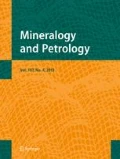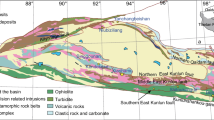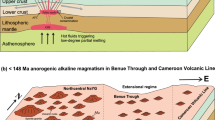Summary
Palladium bismuthotellurides (merenskyite-michenerite-moncheite-melonite) of variable composition and platinum arsenides (sperrylite) are documented in several drill cores of the Las Aguilas mafic-ultramafic intrusion, San Luis province, central Argentina. The mafic-ultramafic rocks ranging in composition from harzburgite to dunite, lherzolite, norite, and gabbro, intruded an amphibolite facies basement causing locally granulite facies metamorphism. The platinum–group minerals (PGM) identified in these rocks occur in (1) unaltered orthopyroxene-rich, plagioclase- and spinel-bearing rocks which carry abundant base-metal sulphides (BMS), such as chalcopyrite, pentlandite, and pyrrhotite; and in (2) serpentinized olivine-rich zones along cracks, but always associated with BMS, spinel, serpentine, and secondary magnetite. Textural evidence suggests a primary magmatic origin as well as late-stage hydrothermal remobilization, transport, and deposition of the PGM. Geophysical exploration and geological field work have delineated the extent of the Cu-Ni sulphide mineralization in the mafic-ultramafic intrusion underlain by a crystalline basement of Ordovician age. It is estimated that platinum-group-element (PGE) – enriched zones of several meters thickness could be present at depth in the mafic-ultramafic intrusion. Chondrite –normalised plots reveal that the ultramafic rocks have a similar PGE fractionation trend as the Bushveld and Stillwater layered complexes. This contrasts with the ophiolite-type ultramafic associations of the Sierras Pampeanas in Cordoba Province, which occur about 400 km to the northeast of the study area.
Zusammenfassung
¶Die Genese von Platingruppenmineralen in mafisch-ultramafischen Gesteinen von Las Aguilas, Provinz San Luis, Argentinien: Texturelle, chemische und mineralogische Befunde
Palladium-Bismuthtelluride (Merenskyit-Michenerit-Moncheit-Melonit) unterschiedlicher Zusammensetzung und Platin-Arsenide (Sperrylit) wurden in mehreren Bohrkernen der mafisch-ultramafischen Intrusion von Las Aguilas, Provinz San Luis, Argentinien, dokumentiert. Die mafisch-ultramafischen Gesteine, die hauptsächlich aus Harzburgiten, Duniten, Lherzoliten, Noriten und Gabbros bestehen, intrudierten ein amphibolitfazielles Grundgebirge, das in den Randbereichen der Intrusion eine granulitfazielle Überprägung zeigt. Platingruppenminerale (PGM) kommen in folgenden Gesteinen vor: (1) in nicht alterierten, Orthopyroxenreichen, Plagioklas- und Spinellführenden Gesteinen, die noch zusätzlich angereichert an Buntmetallsulfiden, wie Chalkopyrit, Pentlandit und Pyrrhotin sind; und (2) entlang von Rissen in serpentinisierten, Olivinreichen Gesteinen, jedoch immer assoziiert mit Buntmetallsulfiden, Spinell, Serpentin und sekundärem Magnetit. Texturelle Beobachtungen zeigen, daß die PGM sowohl primär-magmatisch gebildet als auch in einem hydrothermalen Prozeß remobilisiert, transportiert und wieder auskristallisiert wurden. Mittels geophysikalischer Explorationsmethoden und Geländebeobachtungen konnte die Größe der Cu-Ni-Sulfidmineralisation in der mafisch-ultramafischen Intrusion, die ein ordovizisches Basement überlagert, abgeschätzt werden. Man nimmt an, daß mehrere Meter mächtige Platingruppenelement (PGE)–führende Zonen in bestimmten Tiefen der Intrusion vorkommen. Chondritnormalisierte Diagramme von Gesamtgesteinen zeigen, daß die ultramafischen Gesteine einen ähnlichen PGE Fraktionierungstrend aufweisen wie die lagigen Intrusionen von Bushveld und Stillwater. Dies ist gegensätzlich zu den Ophiolitvorkommen in den Sierras Pampeanas, Provinz Cordoba, die ca. 400 km nordöstlich von unserem Arbeitsgebiet vorkommen.
Similar content being viewed by others
Author information
Authors and Affiliations
Additional information
Received September 15, 1998;/revised version accepted July 21, 1999
Rights and permissions
About this article
Cite this article
Mogessie, A., Hauzenberger, C., Hoinkes, G. et al. Genesis of platinum-group minerals in the Las Aguilas mafic-ultramafic rocks, San Luis Province, Argentina: textural, chemical and mineralogical evidence. Mineralogy and Petrology 68, 85–114 (2000). https://doi.org/10.1007/s007100050005
Issue Date:
DOI: https://doi.org/10.1007/s007100050005




